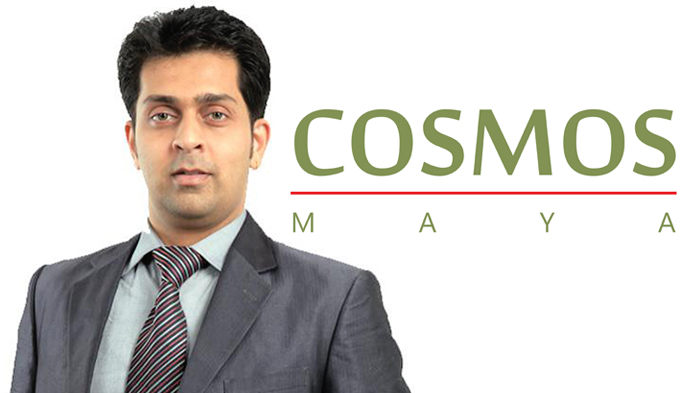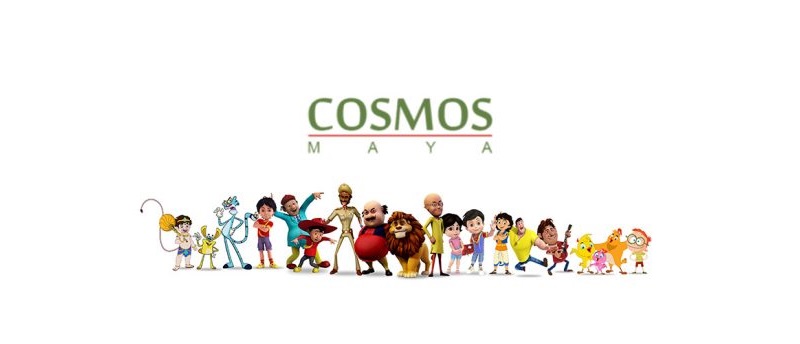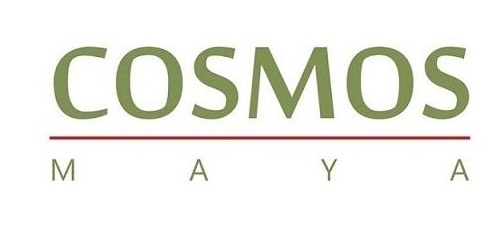
With Hong Kong-headquartered private equity firm New Quest being the recent name to add to the list of its investors, Cosmos Maya – one of India’s most successful animation studios – is indeed going from strength to strength.
Founded by filmmakers Ketan Mehta and Deepa Sahi, the studio is the name behind India’s most beloved shows like Motu Patlu (Nickelodeon) and Selfie with Bajrangi (Disney+ Hotstar) and they have also announced co-production projects like Galactic Agency, The Incredible Monsta Trucks and the third season of Eena Meena Deeka.
We spoke to Cosmos-Maya SVP revenue & corporate strategy Devdatta Potnis to understand the secret sauce behind its meteoric rise, their future plans and the prerequisites to take Indian animation to the next level. While countries like Canada, Australia and Ireland have given major impetus to the business of animation with policy support and government funding, the same can’t be said about India.
Despite the absence of government subsidies and incentives, India has been making one milestone after another in the animation space especially during the lockdown. Speaking on the subject of government subsidies for the animation industry, Potnis informs, “It depends on a country to country basis and on which aspect of the production happens within that country. In certain cases in some countries, it even goes beyond 50 per cent of the entire budget.”
Potnis suggests that writers need to be empowered more if a country wants to progress in the animation industry. Citing examples of western nations, he elaborated, “When you read these articles about Netflix parking a 400 million dollar budget dedicatedly for live action shoots and content that will be created out of Canada, you know that it is because Canada has invested so much into this as a country. The writers are given their due out there. That is not the case in our industry.”

On being asked as to whether it is the absence of government subsidies that is slowing down the pace of Indian animation business, Potnis answers, “While it is great to admire a country like Canada that is doing so much for the entertainment business and animation industry in general, one must keep in mind that in India, there are so many other things from a country’s standpoint that are a priority.”
According to him, the intent should not be to blame the government. Expounding on his perspective, he continues, “We talk about government policies, cash rebates, subsidies and co-production etc. Which country is the world’s number one content producer? It is the USA. Do they have any government policy? No they don’t. It is the entrepreneurial and capitalist outlook that has made America grow.”
Playing to their strengths, what Indian studios lack in subsidies, they have been endeavoring to make up for it in volumes by churning oodles and oodles of content. Potnis revealed that recently Disney+ Hotstar in India commissioned 234.5 hours (which accounts for nine seasons) of Cosmos-Maya’s popular show Selfie With Bajrangi in one go.
Speaking about the efforts that they are making to elevate their profile, he shares, “Even though the budgets aren’t that huge, we are trying to make efforts when you see the volumes. The point I am trying to get at is that whether it is us as a studio or broadcasters or platforms or the other leading studios in the country, we are trying to push for content in some form or another.”
While Motu Patlu‘s story is paying currently rich dividends, Potnis recounts its rocky start. During its pitching stage, many broadcasters were initially critical of the concept. “During the pitching of Motu Patlu, we were talking and it was getting to be this big brand. It hadn’t become a cult yet. Kids finding adults acting like little boys and behaving like bumbling buffoons is interesting and fascinating and that’s the reason Motu Patlu has become what it is today. One broadcaster hadn’t even given us a meeting and now they wish they had supported the idea,” he informs.
He opines that one should not judge too early as the market is unpredictable. He notes, “If one formula starts working, then there is nothing stopping it.”
Taking a Bollywood example, he says, “Before movies like Kahaani or Fashion, there was the notion that girl-centric properties don’t work. But we saw a spate of movies like Dirty Picture, Tanu Weds Manu, Queen, Piku etc. Over the last 10 years, there are dozens of female-led stories.”
He further shares that they follow a ‘familiarity with novelty’ kind of formula. Unpacking its essence, he shares, “So familiarity is when the science comes in so it is not like shocking or bringing something out of the blue but there is a sense of comfort and the novelty is when we try and bring in a spin to the show.”
Selfie With Bajrangi has struck a chord with kids across the country year on year. On being asked about the reason for its continued success, Potnis explains, ”There are four key aspects of Bajrangi. First of all, it is inspired by Bajrang Bali himself.”
With the help of a four letter acronym M.I.S.T, he breaks down the pointers, ‘”M’ for the Mace as the Gada. It could be a multitude of things or contemporary gadgets. ‘I’ for invisibility and all of us here are of the demography that we belong to. Those who are 20 up and under 40 in India right now have at some point in our lives enjoyed Mr India as a child and the flying Hanuman with that invisibility angle comes in over there. Invisible to the rest of the audiences and visible to Ankush so one can even give it an intellectual spin in western parlance, Bajrangi could actually be the inner self of Ankush who is driving him to do things that he doesn’t know he can do. It could be a reflection of his conscience.”
Decoding the rest of the abbreviation further, he shares, “’S’ for Size and Bajrangi had power to increase or decrease in size at will. We tapped into the original aspect of the storytelling that is native to us as Indians. ‘T’ for Tail as I am sure all of us remember the gag from Ramayana where he sits on top of his bundled tail. It is an animation-friendly thing; that tail can double up into anything.”
Potnis believes that the ecosystem will evolve with a combination of factors like ’empowerment of writers, attraction of writing talent, creating a more animation-friendly social set-up (to make animation a vocation of choice), policy level support, subsidies and campaigns to spread the message that it is a great profession to be.’
He adds, “These are big ideas whose implementation to be done at a granular level will be a long process. But once done, you can give wings to anyone’s imagination.”
The scarcity of writing talent in India is one of the concerns that has been highlighted time and time again during various summits and forums. Potnis also pins writing talent deficit as one of the areas Indian animation space needs to work on.
He shares, “If you ask me on a very fundamental level, I think Cosmos-Maya on its part is trying to do a good job with that but we can’t do it on our own. It is not like we don’t have the technology or skill because even Hollywood movies are created in India. It is that writing is not given that kind of importance and this problem is not just limited to animation in India.”
Citing the example of western stories on Netflix and JK Rowling’s Harry Potter, he says that more thought should be given to detailing and character development in India. “Once writers start getting the remuneration and credit for what they do, we will have the best ones coming in.”
Alluding to the growth trajectory of the I.T industry which was not an attractive profession in the past unlike now, Potnis feels that animation should see a similar rise. He shares, “If we could see that mindset evolution and social acceptance, India has a rich treasure trove of stories right from mythology to contemporary fantasy to regional folklore and Hindi literature itself is so rich even state wise. Stories down south or in Gujarat, Maharashtra and Bengal, they have their own theater and literature which is so rich and strong; all of that needs to be a part of animation.”
With various co-production synergies, Cosmos-Maya has breathed life into many global stories for the international audiences. Speaking about the success of international partnerships, he shares, “It’s great when a show like Leo Da Vinci ,for which we partnered with an Italian studio called Grupo Alcuno commissioned by ITV in Italy, does really well on a German Broadcast Network.”
Under the auspices of India’s veteran filmmaker Ketan Mehta, Potnis feels optimistic that the studio will soar higher and higher with stories travelling outwards. He shares, “We are trying to play a larger role where stories from India can travel as well. We have Ketan sir at the helm of everything who has pioneered the crossover storytelling before anyone else could think of it. In 1987, Mirch Masala was made as a bilingual or for example; to adapt a French Classic like Madame Bovary into Maya Memsahab. Ketan sir has always been a champion at that so we’ve got that in the very genes of that system.”
Giving the example of the success other Asian countries like China have witnessed where the animation market shoots up to a 100 million mark, he contrasts, “If an Indian animation film can do better at the box-office than a flop Bollywood movie, we’d be more encouraged to pump in more investments and you can imagine the quality of animation if five-six million dollars are invested.”

He hopes to see more writers from India who can churn out the level of detailing and depth akin to stories like Harry Potter and Disney gems like Zootopia. He explains, “Movies like Zootopia; where my daughter is guffawing away at the gags and marvelling at the animation quality etc.. the script is very much targeting me. There are subtle messages on themes like racism, passive aggressive prejudice and terrorism. So writing is where one needs to work on.”
Maya has historically trained more than 50,000 animation professionals owing to their animation division. Today, the Indian ecosystem is dotted with animation professionals who have, at some point in their lives, received their training at their institute. With no plans of resting on past laurels, the company is continuing its efforts to nurture more creative talents.
With an office presence in Singapore and India, Potnis informs that their content like Eena Meena Deeka has gone to more than 100 countries. With shows like Leo Da Vinci and Berry Bees, they have managed to successfully strike the global chord. “We would love to be on mainstream American television and have a Netflix original, beaming into more than 190 countries,” he concludes.

